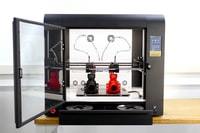An STL file is a type of computer file that can be used to create 3D prints or models. It stands for “Standard Triangle Language,” and it is a format that is used to represent a 3D object as a collection of triangles. Each triangle is defined by three points, which represent the vertices of the triangle.

STL files are created using a variety of software programs, including CAD programs, 3D scanners, and 3D modeling programs.
Once an STL file is created, it can be loaded into a 3D printer-slicing software program. Get an extra 5% off for all items on Creality’s official store website.
This software will slice the STL file into a series of thin layers, which the printer can then use to create the physical object.
The STL file format is a relatively simple format, which makes it easy to create and share 3D models.
To create an STL file, you can use a variety of 3D modeling software programs.
These programs allow you to create 3D models by creating and manipulating vertices, edges, and faces. Once you have created a 3D model, you can export it as an STL file. Save $100 for LD-002H Resin 3D Printer.
STL files are the most common file format for 3D printing. They are a type of 3D file that represents a 3D object as a series of triangles.
This makes them ideal for 3D printing, as the printer can use these triangles to create a physical object.
STL files are created using a variety of software programs, including CAD programs, 3D scanners, and 3D modeling programs.
Once an STL file is created, it can be loaded into a 3D printer-slicing software program. This software will slice the STL file into a series of thin layers, which the printer can then use to create the physical object.
There are a few things to keep in mind when creating STL files for 3D printing.
First, it is important to make sure that the STL file is watertight. This means that there should be no holes or gaps in the object. If there are any holes or gaps, the printer will not be able to create the object properly. CR-Scan Ferret 3D Scanner
Second, it is important to make sure that the STL file is properly oriented. This means that the object should be positioned in the way that the printer expects it to be printed. Buy a scanner, get a free Ender-3 3d printer.
If the object is not properly oriented, the printer may not be able to create it properly.
Finally, it is important to make sure that the STL file is the correct size.
The printer will use the size of the STL file to determine the size of the physical object. If the STL file is the wrong size, the physical object will be the wrong size.
STL files are a versatile and powerful tool for 3D printing. They can be used to create a wide variety of objects, from simple shapes to complex models.
If you are interested in 3D printing, it is important to understand how STL files work.
Additive manufacturing is a process in which a 3D object is created by adding material layer by layer until the entire object is created.
To print an STL file, you will need to slice it into layers. This is done using a slicing software program.
The slicing software program will read the STL file and create a series of G-code files. G-code is a programming language that is used to control 3D printers. Creality CR-M4 3D Printer-New Arrival
The G-code files are then sent to the 3D printer. The 3D printer will read the G-code files and use them to create the physical 3D object.
STL files are a popular format for 3D printing because they are relatively easy to create and share. They are also supported by a wide variety of 3D printers.
If you are interested in 3D printing, then you should learn how to create and use STL files. Best 3D printer named by press-Ender-3 S1 3D Printer
There are a few different ways to create STL files. One way is to use a CAD program.
CAD programs are designed to create 3D models and can be used to create STL files from scratch.
Another way to create STL files is to use a 3D scanner. 3D scanners can create STL files by scanning real-world objects.
Finally, you can create STL files by converting 3D file formats, such as OBJ or FBX files.
Additional tips for working with STL files:
- Make sure that your STL files are well-organized. This will make it easier to find and use them later.
- Use a good quality 3D printer. This will help to ensure that your 3D prints are of high quality.
- Experiment with different settings on your 3D printer. This will help you to get the best results from your prints.
- Don’t be afraid to ask for help. There are many online communities and forums where you can get help with 3D printing.
Yes, it is important to experiment with different settings on your 3D printer in order to get the best results from your prints.
There are many different settings that you can adjust, such as the print speed, layer height, infill percentage, and temperature.
The best settings for your printer will depend on the type of filament you are using, the size of the print, and the desired quality.
Here are some tips for experimenting with different settings on your 3D printer:
- Start with the default settings that are provided with your printer. These settings are a good starting point for most prints.
- Once you have a basic understanding of how your printer works, you can start to experiment with different settings.
- Make small changes to the settings one at a time. This will help you to identify which settings have the biggest impact on the quality of your prints.
- Keep track of the settings that you use for each print. This will help you to reproduce successful prints in the future.
- If you need assistance with 3D printing, don’t hesitate to reach out to the 3D printing community. You’ll find many kind individuals who are eager to offer their expertise and insights.
With a little experimentation, you will be able to find the perfect settings for your 3D printer and start producing high-quality prints.
It is important to note that the best settings for your printer will vary depending on the type of printer you have, the type of filament you are using, and the size and complexity of your print.
- Layer height: The layer height is the thickness of each layer of your print. A higher layer height will result in a faster print, but it will also result in a lower-quality print. A lower layer height will result in a slower print, but it will also result in a higher-quality print.
- Print speed: The print speed is how fast the printer moves the print head. A faster print speed will result in a faster print, but it may also result in a lower-quality print. A slower print speed will result in a slower print, but it will also result in a higher-quality print.
- Infill percentage: The infill percentage is the percentage of the print that is filled with material. A higher infill percentage will result in a stronger print, but it will also result in a heavier print. A lower infill percentage will result in a lighter print, but it may also result in a weaker print.
- Temperature: The temperature of the print head and the build plate can affect the quality of your prints. The correct temperature will vary depending on the type of filament you are using.
- Bed adhesion: Bed adhesion is the ability of the print to stick to the build plate. A good bed adhesion is essential for successful prints. You can do many things to improve bed adhesion, such as using a heated bed, glue stick, or textured build plate.
Conclusion,
With experimentation, you will be able to find the perfect settings for your 3D printer and start producing high-quality prints.
Buy a printer, and get free gifts.
Thanks,
Bullwinkle

